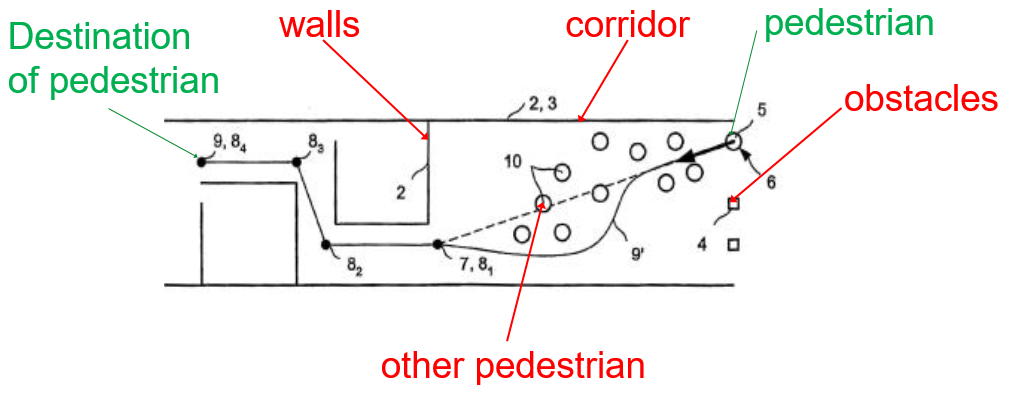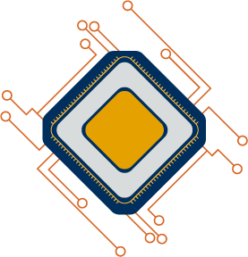The following chapter provides an overview of the examination and appeal procedure underlying decision G1/19 regarding the patenting of a "simulation". In particular, the proceeding and the claimed simulation are discussed. The information is based on the Enlarged Board of Appeal decision G1/19, points 2 to 17.
The application in suit
European patent application 03793825.5, published as international application WO 2004/023347, is entitled “Simulation of the movement of an autonomous entity through an environment”. The invention relates in particular to the modelling and the simulation of movements of a pedestrian in an environment. The simulation of an individual pedestrian’s movement may form part of the simulation of a pedestrian crowd’s movement in a building. Modelling a building and simulating the movement of a crowd within the building may be useful for verifying whether the design of the building fulfils certain requirements, for example in the case of an evacuation of a stadium or a railway station.
Whereas the prior art described in the application used macroscopic models for such purposes (e.g. describing a pedestrian crowd as a quasi-uniform medium, such as a fluid, without regard to individual pedestrians), the approach used in the application is based on the modelling of an individual pedestrian with their own individual intention of reaching a destination, a personal profile – which may include a preferred walking speed and/or a step length – and a surrounding personal space in which the absence of obstacles (building structures and other pedestrians) is sought.
Originally filed claim 1
Originally filed claim 1 reads as follows:
“1. A method of simulating movement of an autonomous entity through an environment, the method comprising:
providing a provisional path through a model of the environment from a current location to an intended destination;
providing a profile for said autonomous entity;
determining a preferred step towards said intended destination based upon said profile and said provisional path;
determining a personal space around said autonomous entity;
determining whether said preferred step is feasible by considering whether obstructions infringe said personal space.”
More detailed explanation of the subject matter
The simulation of crowd movement implies the application of such simulation of an individual’s single step to a large number of individuals and the repetition of this process over a large number of steps. The application contains many parameters which can be used to refine the model of a pedestrian’s movement.
Fig. 2 of the application shows, as a simple example, the possible movement of a pedestrian (5) from a starting location (6) to an ultimate destination (9), moving around walls (2) and other fixed obstacles (4) while avoiding other pedestrians (10).

Pages 11 to 56 of the published application describe a mathematical model of individual pedestrians and an algorithm for simulating their movement through an environment. This is followed, on pages 56 to 70, by the description of a design system which performs the simulation. This system, shown in Figure 21, allows the user to build a model of an environment by creating it or importing a design from a computer-aided-design (CAD) source (page 58, lines 28 to 32). During the execution of the simulation, a sequential set of snapshots is displayed which shows the current position of each pedestrian in the modelled environment. These simulation results can be analysed either online, i.e. while the simulation is running, or offline after the simulation has finished and the results have been recorded (page 60, line 18, to page 61, line 5).
The main purpose of the simulation is its use in a process for designing a venue as shown in Figure 22 and described on pages 65 to 70. Essentially, the designer creates or imports an architectural venue design, specifies the constituents of a pedestrian population that is typical for the venue being designed, and performs a number of simulations of pedestrian flows which the designer can specify at a high level (in terms of sources (entrances), sinks (exits) and supply rate). The simulation results are then examined and the design is revised if necessary.
In addition to the use of the simulation method for designing venues, page 3, lines 17 to 19, of the description also mentions its use for troubleshooting flow problems, operational management, setting and implementing safety standards and quality control. These purposes are not separately elaborated upon elsewhere in the application.
Considerations about human behaviour
There are aspects of the simulation which are based not only on physical boundaries (such as the walls of an “environment” or building) but also on considerations about human behaviour, such as a “personal space” in which no obstacles are tolerated.
Examination Proceeding / Decision under Appeal
In the course of the examination proceedings, the claimed methods were limited, inter alia, by specifying that the methods were “computer-implemented” and by further limiting the parameters underlying the “preferred step” taken by the autonomous entity.
In its decision to refuse the application, the examining division held that only the use of a computer contributed to the technical character of the claimed method. Consequently, the technical problem to be solved was formulated as technically implementing a method of simulating the movement of an autonomous entity through an environment comprising the steps defined in the pertinent claim. The solution of said problem, namely the use of a computer, was not inventive.
Appeal Proceedings
In its appeal against the refusal, the appellant argued in particular that the method steps of the claimed invention were technical features or physical parameters. Even if the method steps were considered to be non-technical, they still contributed to the technical character of the invention since they resulted in a technical effect by virtue of their interaction with the computer. Reference was made to T 641/00 (COMVIK, OJ EPO 2003, 352) and to T 1227/05 (OJ EPO 2007, 574), the latter concerning simulations.
In its communication accompanying the summons to oral proceedings, the referring board took the view that the steps forming the claimed method were in themselves non-technical and could contribute to the technical character of the claim only to the extent that their combination interacted with the technical features of the claim to produce a technical effect. Such a technical effect could be present if the design of the simulation steps was motivated by technical considerations of the internal functioning of the computer on which the simulation was implemented, or if the technical effect was part of the overall purpose of the claimed method. The referring board tended to the view that the claimed simulation method did not serve a technical purpose and therefore did not contribute to the technical character of the invention.
Claims of the requests in the appeal proceeding
Claim 1 of the main request underlying the referring decision reads as follows (reference signs omitted):
“1. A computer-implemented method of modelling pedestrian crowd movement in an environment, the method comprising:
simulating movement of a plurality of pedestrians through the environment, wherein simulating movement of each pedestrian comprises:
providing a provisional path through a model of the environment from a current location to an intended destination;
providing a profile for said pedestrian;
determining a preferred step, to a preferred position, towards said intended destination based upon said profile and said provisional path, wherein determining said preferred step comprises determining a dissatisfaction function expressing a cost of taking a step comprising a sum of an inconvenience function expressing a cost of deviating from a given direction and a frustration function expressing a cost of deviating from a given speed;
defining a neighbourhood around said preferred position; identifying obstructions in said neighbourhood, said obstructions including other pedestrians and fixed obstacles;
determining a personal space around said pedestrian; determining whether said preferred step is feasible by considering whether obstructions infringe said personal space over the course of the preferred step.”
Claim 1 of the first auxiliary request differs from claim 1 of the main request in that “environment” is replaced by “building structure”.
The second auxiliary request differs from the first auxiliary request in that certain details about the pedestrian’s walking speed are added.
Claim 1 of the third auxiliary request differs from claim 1 of the second auxiliary request in that the following is added at the end of the claim: “and displaying the simulated movement as a sequential set of snapshots showing the current position of each pedestrian in the model as it progresses over time”.
The fourth auxiliary request differs from the higher-ranking requests in that it refers to methods of iteratively designing a building structure. Its claim 1 differs from claim 1 of the third auxiliary request in that the beginning of the claim (the text before “providing a provisional path”) is replaced by:
“1. A method of designing a building structure, the method comprising: providing a model of said building structure; simulating movement of a plurality of pedestrians through said building structure using a computer, wherein simulating movement of each pedestrian step comprises:”
and in that the following text is added at the end of the claim:
“and revising said model of said building structure in dependence upon movement of the pedestrians”.
The fifth auxiliary request is also based on the third auxiliary request, claiming methods of modelling pedestrian crowd movements. Its claim 1 differs from claim 1 of the third auxiliary request in that the following text is inserted before “and displaying the simulated movement”:
“if the preferred step is not feasible, then:
determining a region in which to seek a compromise step, wherein determining the region in which to seek the compromise step comprises adapting step parameters for determining said region in dependence upon memory of past conditions; and
determining whether at least one compromise step is feasible;”
Conclusion
The Board of Appeal considers the subject-matter of the invention not to be inventive. However, the Board of Appeal considered that certain aspects needed to be clarified by the Enlarged Board of Appeal. For this reason, it drafted questions for reference to the Board of Appeal in an interlocutory decision. These will be discussed in more detail in the next chapter.
